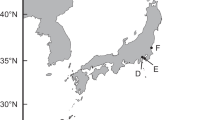Abstract
Previously, we have demonstrated that such secondary metabolites as phosphoethanolamine (PE) and phosphoserine (PS) are low-temperature adaptogens specific to the brain of freshwater fish, in contrast to taurine which serves as an adaptogen in fish muscles and blood plasma. Here, we carry on investigating the role of PE, PS, taurine and proteinogenic amino acids in adaptation of poikilothermic animals to low temperatures. PE and PS were discovered in the brain of the frog Rana temporaria, and their pools were shown to increase by the onset of hibernation compared to the summer period almost in a similar manner (PE—from 0.22 to 1.65, PS—from 0.29 to 1.98 µmol/g wet weight). Unlike the fish brain, in the R. temporaria brain, the PE/PS ratio was almost indistinguishable in the winter compared to the summer. In contrast to fish, in the R. temporaria brain, the taurine level increased from 0.77 µmol/g in the summer to 1.37 µmol/g in the winter. The level of aspartic acid, which was missing in the fish brain during the winter, in the R. temporaria brain sharply increased by the onset of hibernation from 0.86 to 4.60 µmol/g. Thus, there is ground to believe that such secondary metabolites as PE, PS, taurine and proteinogenic aspartic acid play the role of low-temperature adaptogens in the brain of anuran amphibians.
Similar content being viewed by others
REFERENCES
Storey, K.B. and Storey, J.M., Molecular physiology of freeze tolerance in vertebrates, Physiol. Rev., 2017, vol. 97(2), pp. 623–665.
Storey, K.B. and Storey, J.M., Biochemical adaptation to extreme environments, Integrative Physiology in the Proteomics and Post-Genomics Age, Walz, W., Ed., 2010, Totowa, N.J., pp. 169–200.
Karanova, M., Influence of low temperature on the evolution of amino acids pools adaptive modifications in poikilothermic animals: a review, Int. J. Biochem. Biophys., 2013, vol. 1(2), pp. 33–40.
Karanova, M.V. and Gakhova, E.N., Biochemical strategy of survival of the freshwater mollusc Lymnaea stagnalis at near-zero temperatures, J. Evol. Biochem. Physiol., 2007, vol. 43(3), pp. 310–317.
Karanova, M.V., Free amino acid composition in blood and muscle of the gobi Precottus glehni at the period of preparation and completion of hibernation, J. Evol. Biochem. Physiol., 2009, vol. 45(1), pp. 67–77.
Karanova, M.V. and Andreev, A.A., Free amino acids and reducing sugars in the freshwater shrimp Gammarus lacustris (Crustacea, Amphipoda) at the initial stage of preparation to winter season, J. Evol. Biochem. Physiol., 2010, vol. 46(4), pp. 335–340.
Karanova, M.V. and Ivlicheva, N.A., Pool of phosphoethanolamine and phosphoserine in the brain of the snail Lymnaea stagnalis L. in summer and before winter dormancy, J. Evol. Biochem. Physiol., 2016, vol. 52(2), pp. 127–132.
Karanova, M.V., Identification of phosphoethanolamine and phosphoserine in the brain of the pond fish Perccottus glehni (Eleotridae, Perciformes, Dyb. 1877), Neurosci. Behav. Physiol., 2016, vol. 46(7), pp. 803–807.
Karanova, M.V., Impact of seasonal temperature decrease and cold shock on the composition of free amino acids and phosphomonoethers in various organs of amur sleeper Percottus glenii (Eleotridae), J. Ichthyol., 2018, vol. 58(4), pp. 570–579.
Karanova, M.V., Effects of cold shock on responses of phosphomonoesters and free amino acids in phospholipid-rich organs in the Amur sleeper Perccottus glehni, Neurosci. Behav. Physiol., 2018, vol. 48(5), pp. 528–533.
Spachman, D.H., Stein, W.H., and Moore, S., Automatic recording apparatus for use in the chromatography of amino acids, Anal. Chem., 1958, vol. 30(7), pp. 1190–1206.
Baxter, C.F., Baldwin, R.A., Lu, P., Imaki, H., and Sturman, J.A., Taurine in toad brain and blood under different conditions of osmolality: an immunohistochemical study, Neurochem. Res., 1993, vol. 18(4), pp. 425–435.
Watanabe, M., Shimada, M., Watanabe, H., and Nakanishi, M., Amino acid content in several brain regions of the active and hibernating frog, Rana esculenta, Comp. Biochem. Physiol., 1990, vol. 978(3), pp. 605–610.
Raheem, K.A and Mosallamy, N.El., Metabolism of hibernating reptiles, Changes in free amino acids in the blood, liver and brain, Comp. Biochem. Physiol., 1979, vol. 64(B), pp. 305–308.
Bekshokov, K.S., Emirbekov, E.Z., and Emirbekova, A.A., Response of neurotransmitter pool of amino acids of ancient brain structures to low temperatures in heterothermes, Izv. Vuzov. Severo-Kavkazskii Reg., Est. Nauki, Prilozh., 2004, S6, pp. 42–46.
Al-Badry, K.S. and Taha, H.M., Hibernation hypothermia and metabolism in hedgehogs--changes in free amino acids and related compounds, Comp. Biochem. Physiol. A, 1982, vol. 72(3), pp. 541–547.
Ozernyuk, N.D., Temperaturnye adaptatsii (Temperature Adaptations), Moscow, 2000.
ACKNOWLEDGMENTS
The author is grateful to V.Ya. Lysanskaya for the aid in performing amino acid analysis and Dr. V.K. Uteshev for the delivery of frogs.
Funding
This work was implemented within a state assignment to the Institute of Cell Biophysics, Russian Academy of Sciences (reg. no. 0116-2014-0001).
Author information
Authors and Affiliations
Corresponding author
Ethics declarations
All applicable international, national and institutional principles of handling and using experimental animals for scientific purposes were observed. This study did not involve human subjects as research objects.
Rights and permissions
About this article
Cite this article
Karanova, M.V. Secondary Metabolites and Aspartic Acid in the Brain of the Frog Rana temporaria as Low-Temperature Adaptogens. J Evol Biochem Phys 56, 218–223 (2020). https://doi.org/10.1134/S0022093020030047
Received:
Revised:
Accepted:
Published:
Issue Date:
DOI: https://doi.org/10.1134/S0022093020030047




